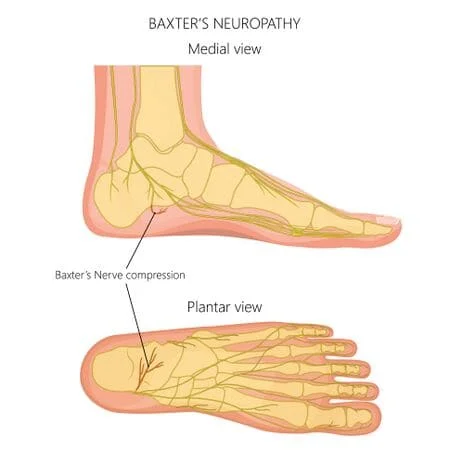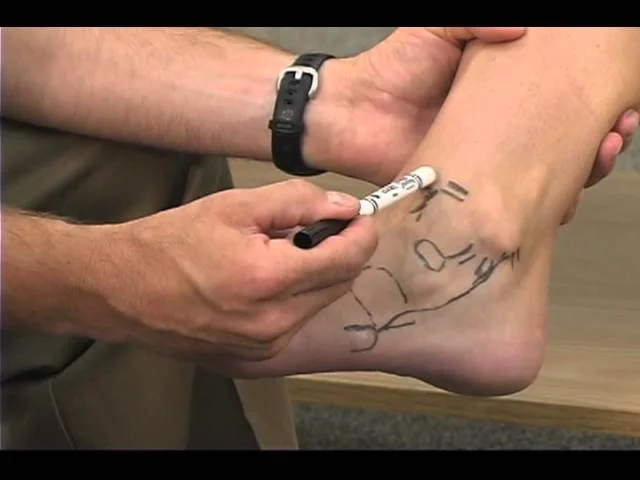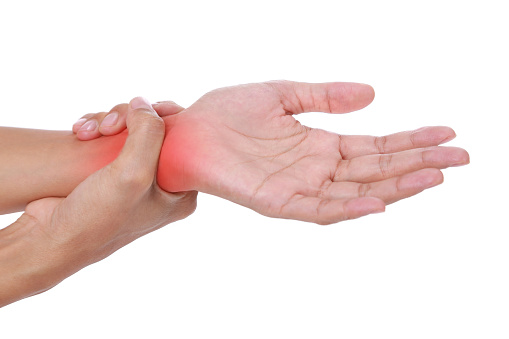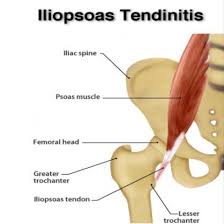Baxter’s Nerve Entrapment
What is a Baxter’s Nerve Entrapment?
Baxter’s nerve entrapment, also known as inferior calcaneal nerve entrapment, is a painful condition that affects the heel area of the foot. It involves the entrapment or compression of the first branch of the lateral plantar nerve, which supplies sensation to the heel pad. This condition often leads to chronic, debilitating pain that can significantly impede an individual’s mobility and quality of life.
The entrapment typically occurs as the nerve passes through the tarsal tunnel, a narrow space on the inside of the ankle that houses various nerves, blood vessels, and tendons. Compression of the nerve can result from various factors, including repetitive trauma, excessive pressure on the heel, anatomical abnormalities, or inflammatory conditions.
Related Anatomy
The inferior calcaneal nerve, or Baxter’s nerve, is the first branch of the lateral plantar nerve to emerge from the tarsal tunnel. The lateral plantar nerve supplies motor fibers to the abductor digiti minimi, flexor digitorum brevis, and quadratus plantae, as well as sensory components to the calcaneal periosteum, the long plantar ligament, and the lateral plantar skin.
The lateral plantar nerve’s first branch can start from the tibial nerve before or close to its bifurcation. It can also originate from the lateral plantar nerve itself. After that, it descends through the superficial fascia at the abductor’s superior border. Because of the strength provided by the interfascicular ligament in connection with the medial intermuscular septum, the investing fascia of the abductor is thicker laterally at this level.
It passes between the medial margin of the quadratus and the lateral abductor fascia distally. After it crosses the lower border of the abductor hallucis, it turns and courses laterally, going between the quadratus and the underlying flexor brevis and 5.5 mm anterior to the medial calcaneal tuberosity (or spur). Eventually, it reaches the distal goal of the abductor digiti minimi.
Causes of Baxter’s Nerve Entrapment
Due to its route, Baxter’s nerve is susceptible to entrapment; the tight fascia of the abductor hallucis and the medial aspect of the quadrates plantae muscle are the most typical sites. Although two points have been put out as potential causes of entrapment.
The first is the location of the nerve’s lateral turn, which occurs between the thick lateral fascia of the abductor hallucis and the medial edge of the quadratus plantae.
The second location is where the nerve passes in front of the spur or tuberosity. Pronation of the rearfoot/midfoot complex, resulting in impingement at the acute turn of the nerve, and/or an increase in cubic contact of this channel (by a spur or muscle hypertrophy) are two potential predisposing circumstances.
Multifactorial factors including different anatomical, mechanical, and pathological elements can be the cause of Baxter’s nerve entrapment. Typical reasons and aggravating elements could be:
Anatomical Abnormalities
The tarsal tunnel may shrink due to structural differences in the foot, such as a hypertrophied sustentaculum tali or a low-lying abductor hallucis muscle, which can compress the nerve.
Injury
Inflammation and subsequent nerve entrapment can arise from repetitive microtrauma or direct injury to the heel area, frequently as a result of activities involving severe impact or pressure on the foot.
Footwear
Badly fitting shoes can exacerbate or cause the development of Baxter’s nerve entrapment, particularly if they are too tight around the heel or provide insufficient support.
Inflammatory Conditions
Entrapment of nerves can result from swelling and increased pressure within the tarsal tunnel caused by inflammatory disorders such as arthritis, tarsal tunnel syndrome, or diseases affecting adjacent tendons.
Foot Biomechanics
The distribution of weight and pressure in the foot can be changed by abnormalities in foot biomechanics, such as overpronation or oversupination, which raises the risk of nerve entrapment.
Understanding the underlying causes of Baxter’s nerve entrapment is crucial for accurate diagnosis and the implementation of effective treatment strategies.
Symptoms of Baxter’s Nerve Entrapment
Baxter’s nerve entrapment symptoms can vary widely in intensity and appearance, frequently resulting in chronic pain and impaired function.
Most common symptoms are:
- Heel Pain: The most common pain felt by patients in the heel is usually severe, stabbing, or burning, especially when they are walking, running, or standing for long periods of time. Long-term exercise may make the discomfort worse; resting will help it get better.
- Tenderness above the origin of the abductor hallucis, which may cause paraesthesia or discomfort that radiates laterally.
- A severe radiating pain that gets worse at night and after exertion (like walking).
- The abductor digiti minimi muscle has moderate atrophy.
- Soreness throughout the medial calcaneus.
Differential Diagnosis
- Plantar fasciitis
- Seronegative arthritis-induced inflammation
- Tarsal tunnel syndrome
- Medial calcaneal neuritis
- Heel spurs
- Trauma
- Fat pad atrophy
- Calcaneal stress fractures
- Periosteal inflammation
- Achilles Tendinopathy
- Rheumatoid Arthritis
- Heel Pad Syndrome
Diagnosis
A thorough assessment that combines medical expertise, physical examination, and diagnostic imaging methods is usually required to diagnose Baxter’s nerve entrapment. Important elements of the diagnostic procedure for Baxter’s nerve entrapment include the following:
Patient History
Physical Examination:
To check for any apparent evidence of inflammation or structural anomalies, as well as for localized soreness and swelling, a comprehensive physical examination of the foot, ankle, and lower leg is necessary. Finding the causes of nerve compression can also be aided by analyzing the patient’s stride and looking for any anomalies in foot biomechanics.
A pronated foot structure is typically observed by therapists during the biomechanical evaluation.
Special tests
- Tinel’s test
- Phalen’s test
- To rule out plantar fasciitis, use the windlass test.
Imaging Study and Bone Scan
Bone scans and basic radiographs can be used to rule out osseous pathology.
Diagnostic Ultrasound
Serologic testing
Systemic arthropathy may be ruled out using serologic testing.
Treatment of Baxter’s Nerve Entrapment
Medical treatment
The goals of treatment for Baxter’s nerve entrapment are to lessen nerve compression, relieve symptoms, and enhance the patient’s general well-being. Depending on the severity of the condition and the unique demands of each patient, the therapeutic strategy frequently combines non-surgical and surgical approaches.
The most common treatment options are:
Rest and Activity Modification
Orthotic Devices
In order to correct biomechanical abnormalities, realign pressure on the foot, and reduce strain on the injured nerve, custom orthotic devices or shoe inserts can be used.
Physical Therapy
A physical therapist can prescribe specific stretching and strengthening exercises to help improve foot biomechanics, lessen muscular imbalances, and ease the discomfort of entrapped nerves in the foot.
Kinesio taping
Stretching and strengthening exercises at the foot.
Cryoablation, radiofrequency, hydrodissection using 5% dextrose
Medications
Corticosteroid injections or nonsteroidal anti-inflammatory drug (NSAID) therapy may be administered to lower inflammation, relieve pain, and enhance the patient’s general comfort and movement.
Ultrasound-guided corticosteroid injection
Surgical Intervention
Surgical decompression of the affected nerve may be considered if conservative therapy are ineffective in relieving the condition. By increasing the amount of space in the tarsal tunnel and alleviating pressure on the nerve, this operation seeks to improve nerve function and relieve symptoms.
Note:
The intensity of symptoms, the existence of any underlying medical disorders, the patient’s lifestyle, and their level of activity should all be taken into consideration when creating treatment programs for individual patients.
Summary
Baxter’s nerve entrapment is a painful condition that can significantly impact an individual’s mobility and quality of life. It causes symptoms including tingling, numbness, and heel discomfort by compressing the first branch of the lateral plantar nerve. For proper management and therapy, an extensive evaluation that provides an early diagnosis is essential.
In many situations, conservative methods including rest, physical therapy, orthotic devices, and medication can effectively relieve symptoms. Rarely require surgical intervention. Patients can see a decrease in symptoms and an improvement in their overall functional status with the right care, which emphasizes the value of a multidisciplinary approach to managing this difficult condition.
FAQs
What does Baxter’s nerve entrapment feel like?
Sharp, intense pain in the heel is the classic symptom of Baxter’s nerve entrapment. It is sometimes accompanied by tingling, numbness, and an electric shock-like sensation that travels from the heel to the arch of the foot. It may result in reduced movement and everyday activities as well as increased sensitivity to touch.
How do you fix Baxter’s nerve entrapment?
Conventional Treatment Options for Baxter’s nerve entrapment are:
Rest.
Cold therapy.
Pain Relieving Medicines
Physical therapy.
Custom orthotics
Exercises
Activity Modification
Rarely Surgery
How long does Baxter’s nerve last?
Twenty percent of patient cases of chronic heel pain are caused by Baxter’s nerve entrapment. Treatment is frequently postponed and the pain can last for months or even years because the condition is frequently disregarded and misdiagnosed as plantar fasciitis.
How long does Baxter’s nerve entrapment take to heal?
Depending on the severity of the problem and the treatment plan selected, there is a variation in the healing time for Baxter’s nerve entrapment. Some people may feel better in a matter of weeks to months with the right care, which may include rest, counseling, and potentially surgery. Full healing, however, varies from case to case and may take longer.
How do you test for Baxter’s neuropathy?
Diagnostic Ultrasound
A diagnosis of Baxter’s neuropathy cannot be definitively confirmed by a clinical evaluation on its own. Diagnostic ultrasound and other medical imaging procedures are the only ways to confirm Baxter’s neuropathy.
How do you treat Baxter’s nerve at home?
When treating Baxter’s nerve entrapment at home, non-steroidal anti-inflammatory medicines (NSAIDs), rest, ice, and painful activity restriction should be your initial course of treatment.
References
Baxter’s Nerve Entrapment. (n.d.). Physiopedia. https://www.physio-pedia.com/Baxter’s_Nerve_Entrapment







